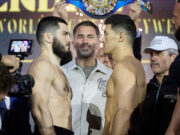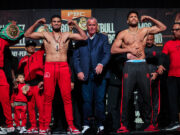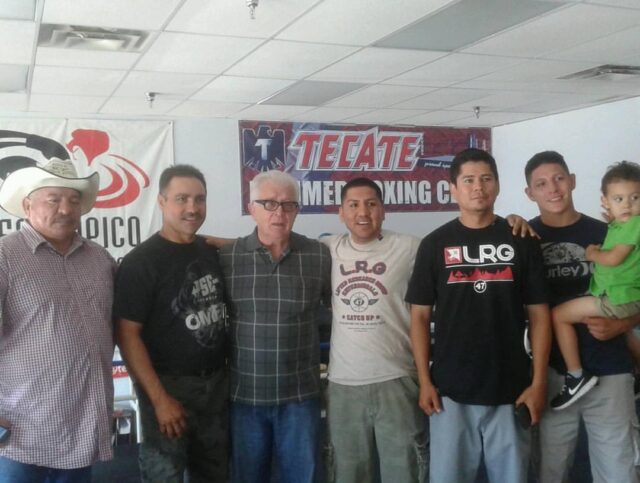By Norm Frauenheim
Willy Borchert, an electrician from nine-to-five and a trainer all the time, was a builder. He built a gym. He built fighters. He built a legacy that is fundamental to a city’s enduring and evolving reputation as a fight town.
He’s gone. Borchert died this week, Monday morning, after several years of battling health issues. He was 80. No services are planned.
But the Borchert legacy is there — very much alive — throughout Phoenix, a city with deep boxing roots in neighborhoods across its sprawling landscape. Kids have been skipping rope on sidewalks in front of a downtown barber shop and sparred within corroding hoses for ropes in backyard rings for years. It’s not a game, and it never has been in Phoenix, where it’s craft and culture, a mom-and-pop tradition.
It’s still there, a gritty element in the PHX DNA, in large part because of the way Borchert and his surviving wife, Nettie, sustained it with parental care for more than two decades, throughout the 1980s and into the 90s.
After working at his day job in the construction of Palo Verde nuclear power plant in Tonopah, Willy came home and proceeded to build an outdoor, ramshackle gym behind the Borchert home between Camelback and Indian School roads, just west of I-17.
Kids in the surrounding neighborhoods noticed. It was a refuge from the mean streets, a place to fight and a place to learn how.
A teen-aged Louie Espinoza showed up and a few years later became the first Arizona-born fighter to win world title belts, the World Boxing Association’s 122-pound version in 1987 and the World Boxing Organization’s featherweight version in 1989.
At about the same time, in walked Johnny Vasquez, an aggressive and entertaining bantam and junior-featherweight contender who was an amateur rival to Arizona’s reigning name, Michael Carbajal, a 1988 Olympic silver medalist and the state’s only Hall of Famer.
Carbajal had a street near his downtown home named after him last year. Vasquez called himself The Torch for the fires he set as a teen-aged arsonist. He kept the nickname as a fighter because Borchert taught him how to focus his energies for the fire that was so evident within the regulated ropes.
There was middle/super-middleweight Jesus Ernesto Gonzales, light-heavyweight Earl Butler Jr. and junior-featherweight Ray Martinez Jr., too. Borchert was a teacher, a father figure to rough kids willing to learn. Top Rank noticed, hiring Borchert to be Diego Corrales’ first pro trainer.
Corrales, who died in a 2007 motorcycle accident, had a troubled past as a kid growing up in Sacramento. Enter Borchert. Corrales, a Hall of Famer, lived and trained at Willy’s Boxing Studio throughout 1996. He fought four of his first five pro bouts in Phoenix before going on to a Hall of Fame career that included the 2005 10th-round stoppage for the lightweight title of Jose Luis Castillo, a wildly dramatic fight which ranks among the best in boxing’s long history.
Borchert taught fundamentals.
In the ring.
And outside of it.
But it didn’t always work. Kids fight for a reason, often to just survive. Some don’t.
In 1995, Borchert lost the kid he thought might one day be his best ever. He was Geronimo Deciga, who was eight years old when he walked into the gym with Espinoza, his boyhood hero. Deciga went on to win a national Police Athletic League title at flyweight in 1994. He was beginning to train for a jump up to 119 pounds for a bid as a leading contender for the U.S. team at the 1996 Atlanta Olympics.
Within the first two weeks of 1995, however, the 16-year-old Deciga was dead, the victim of a drive-by shooting in the 3000 block of West Granada Avenue. In a story for The Arizona Republic, Borchert was heartbroken.
“Geronimo died in the hospital on life support,’’ Borchert told me. “I put my hand on his leg. I kept thinking he’d wake up, get out of bed and start hitting the bag. I mean, he was always there, always working. But he just laid there, and I couldn’t take it. I thought I was stuck in a bad dream.
“…I don’t know if I can ever get over Geromino’s death. That’ll hurt me forever, I guess.’’
Four-and-half years later, Borchert sold the gym. He and Nettie moved on. But they were never forgotten. In any conversation with Espinoza, Vasquez, Gonzales, Butler and Martinez, Borchert’s name comes up. They’ve never forgotten what he did for them.
It’s been more than 25 years since Borchert left the gym. Left a young fighter’s corner. These days, Phoenix’s reputation as a great fight town has grown. In Phoenix fights featuring rising star Jesse “Bam” Rodriguez of San Antonio, UK promoter Eddie Hearn always mentions how much he likes the Phoenix fan base and its appreciation for the smallest weight classes.
Phoenix fans, Hearn says, are “educated.’’
They are in large part because of the years Willy and Nettie Borchert were mom-and-pop to tough kids. Willy taught them how to fight. Nettie cooked the meals. Willy’s Boxing Studio was home for many of them.
Over the last year, the Phoenix market has been lost in a shuffle bought on by Saudi money. But the city’s DNA will survive, meaning PHX will continue to be a destination for promoters. It stays on the map because Borchert helped keep it there.
David Benavidez, the current World Boxing Council’s light-heavyweight champion and ranked among the second five in the latest pound-for-pound debate, continues to identify himself as a Phoenix fighter, even though he lives in Miami and had been training in the Seattle area.
He wears the PHX logo on the waistband to his trunks. In the media, he’s consistently called a Phoenix fighter. That’s no coincidence. Benavidez grew up not far from Willy’s Boxing Studio, for decades a cornerstone to a city’s reputation for producing fighters who know how to fight.
Who love to fight.
Rest-In-Peace, Willy Borchert
























